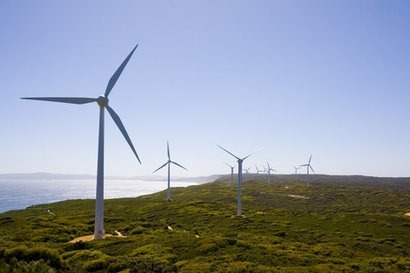
Improved rainfall in key hydro catchments and a series of new wind and solar projects helped to make 2016 a record year for renewable energy in Australia according to the Clean Energy Council’s Clean Energy Australia Report 2016. The report finds that more than 17 per cent of Australia’s electricity came from renewable energy during the year – the highest proportion at any time this century, putting Australia well on track to deliver the 2020 Renewable Energy Target (RET).
Clean Energy Council Chief Executive Kane Thornton said 10 large wind and solar projects had been completed last year, with continued reductions in project costs contributing to unprecedented levels of commercial activity, setting the industry up for another record year in 2017.
“Every month brings new project announcements” said Mr Thornton. “While total investment in large-scale renewable energy was $2.56 billion last year, $5.20 billion worth of projects have secured finance in just the first five months of 2017 and have either started construction or will begin this year. The installation of rooftop solar systems was steady during 2016, with 135,370 systems installed throughout the year. This has also accelerated in 2017 with the industry posting its largest ever March quarter for rooftop solar, and the biggest of any quarter since August 2012.”
Mr Thornton added that the changes that are happening across the country right now are extraordinary. Renewable energy is now the cheapest kind of new power generation that can be built today – less than both new coal and new gas-fired power plants. The price of gas in particular has skyrocketed whereas large-scale solar power is almost half the cost it was just a couple of years ago, and is now playing a huge role in meeting the national Renewable Energy Target (RET). Innovation continues right across the renewable energy supply chain and new technologies such as energy storage are beginning to appear.
While the latest available employment figures show an industry contraction to 11,150 direct jobs in the 2015-16 financial year, these figures cover a low point for the sector following the Abbott Government’s RET review. Employment figures are likely to increase substantially in 2017 with over 35 large-scale projects already under construction or starting this year, adding up to more than $7.5 billion in investment and more than 4100 additional direct jobs.
Highlights from the report include the finding that 17.3 percent of Australian electricity came from renewable energy during 2016, the most of any year so far during the 21st century. Hydro made the biggest contribution, providing 42.3 percent of the total renewable energy following excellent rainfall in key hydro catchments. Non-hydro renewable energy such as solar, wind and bioenergy delivered 10 percent of Australian power in 2016.
The projects which have reached financial close in the first five months of 2017 add up to $5.20 billion - more than twice the investment in large-scale renewable energy for the whole of 2016. The Australian Capital Territories (ACT) Government’s reverse auction programme led to the cheapest wind power ever contracted, for $73 a megawatt-hour at Neoen’s Hornsdale 3 Wind Farm. The wind Farm in Victoria led to Origin Energy contracting renewable energy from the project for less than $60/MWh.
Half of the projects which are under construction or will start in 2017 under the RET are large-scale solar, due to a plunge in costs over the last few years. Support from the Australian Renewable Energy Agency (ARENA) and innovative finance from the Clean Energy Finance Corporation (CEFC) have pushed the price of large-scale solar down to almost half what it was just a couple of years ago. Tasmania’s energy crisis was resolved following the repair of the Basslink cable connecting the island with the mainland, combined with strong winter rains. Ten new renewable energy projects came online in 2016 – Seven solar plants and three wind farms. 6,750 battery systems were installed in 2016, 13 times the number that were installed in 2015.
Image: Albany wind farm, Australia
For additional information:

